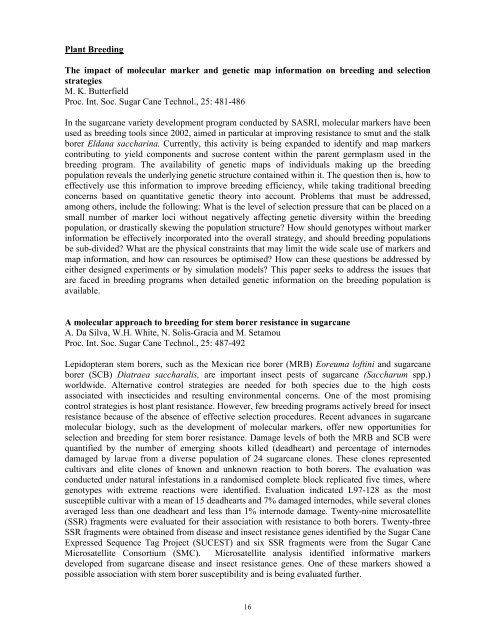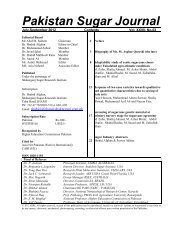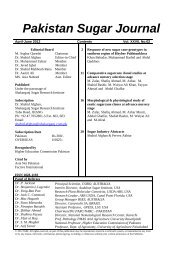Sep to Oct 2006 - Shakarganj
Sep to Oct 2006 - Shakarganj
Sep to Oct 2006 - Shakarganj
Create successful ePaper yourself
Turn your PDF publications into a flip-book with our unique Google optimized e-Paper software.
Plant Breeding<br />
The impact of molecular marker and genetic map information on breeding and selection<br />
strategies<br />
M. K. Butterfield<br />
Proc. Int. Soc. Sugar Cane Technol., 25: 481-486<br />
In the sugarcane variety development program conducted by SASRI, molecular markers have been<br />
used as breeding <strong>to</strong>ols since 2002, aimed in particular at improving resistance <strong>to</strong> smut and the stalk<br />
borer Eldana saccharina. Currently, this activity is being expanded <strong>to</strong> identify and map markers<br />
contributing <strong>to</strong> yield components and sucrose content within the parent germplasm used in the<br />
breeding program. The availability of genetic maps of individuals making up the breeding<br />
population reveals the underlying genetic structure contained within it. The question then is, how <strong>to</strong><br />
effectively use this information <strong>to</strong> improve breeding efficiency, while taking traditional breeding<br />
concerns based on quantitative genetic theory in<strong>to</strong> account. Problems that must be addressed,<br />
among others, include the following: What is the level of selection pressure that can be placed on a<br />
small number of marker loci without negatively affecting genetic diversity within the breeding<br />
population, or drastically skewing the population structure? How should genotypes without marker<br />
information be effectively incorporated in<strong>to</strong> the overall strategy, and should breeding populations<br />
be sub-divided? What are the physical constraints that may limit the wide scale use of markers and<br />
map information, and how can resources be optimised? How can these questions be addressed by<br />
either designed experiments or by simulation models? This paper seeks <strong>to</strong> address the issues that<br />
are faced in breeding programs when detailed genetic information on the breeding population is<br />
available.<br />
A molecular approach <strong>to</strong> breeding for stem borer resistance in sugarcane<br />
A. Da Silva, W.H. White, N. Solis-Gracia and M. Setamou<br />
Proc. Int. Soc. Sugar Cane Technol., 25: 487-492<br />
Lepidopteran stem borers, such as the Mexican rice borer (MRB) Eoreuma loftini and sugarcane<br />
borer (SCB) Diatraea saccharalis, are important insect pests of sugarcane (Saccharum spp.)<br />
worldwide. Alternative control strategies are needed for both species due <strong>to</strong> the high costs<br />
associated with insecticides and resulting environmental concerns. One of the most promising<br />
control strategies is host plant resistance. However, few breeding programs actively breed for insect<br />
resistance because of the absence of effective selection procedures. Recent advances in sugarcane<br />
molecular biology, such as the development of molecular markers, offer new opportunities for<br />
selection and breeding for stem borer resistance. Damage levels of both the MRB and SCB were<br />
quantified by the number of emerging shoots killed (deadheart) and percentage of internodes<br />
damaged by larvae from a diverse population of 24 sugarcane clones. These clones represented<br />
cultivars and elite clones of known and unknown reaction <strong>to</strong> both borers. The evaluation was<br />
conducted under natural infestations in a randomised complete block replicated five times, where<br />
genotypes with extreme reactions were identified. Evaluation indicated L97-128 as the most<br />
susceptible cultivar with a mean of 15 deadhearts and 7% damaged internodes, while several clones<br />
averaged less than one deadheart and less than 1% internode damage. Twenty-nine microsatellite<br />
(SSR) fragments were evaluated for their association with resistance <strong>to</strong> both borers. Twenty-three<br />
SSR fragments were obtained from disease and insect resistance genes identified by the Sugar Cane<br />
Expressed Sequence Tag Project (SUCEST) and six SSR fragments were from the Sugar Cane<br />
Microsatellite Consortium (SMC). Microsatellite analysis identified informative markers<br />
developed from sugarcane disease and insect resistance genes. One of these markers showed a<br />
possible association with stem borer susceptibility and is being evaluated further.<br />
16






